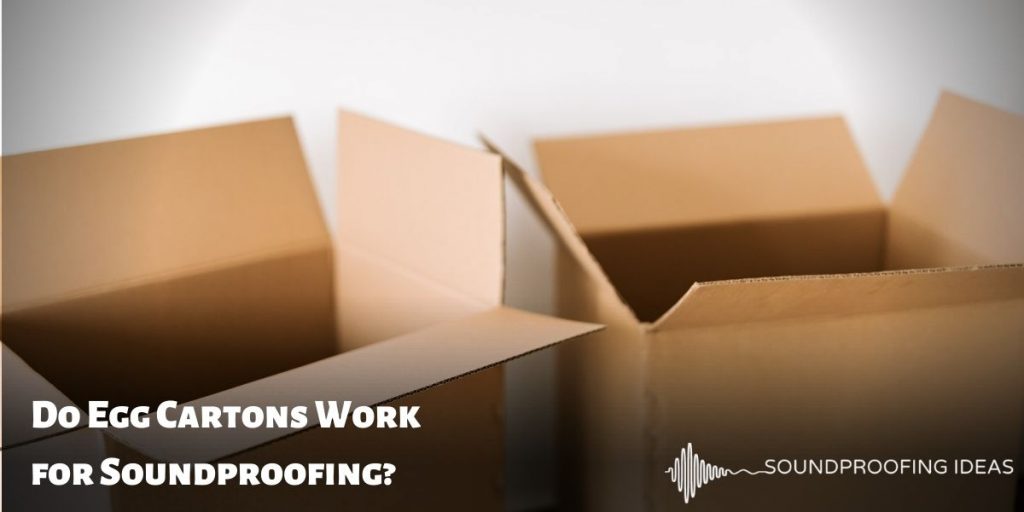Your neighbor is too loud and you have a pile of old cardboard boxes in the basement. Now the idea comes to you to attach the cardboard to the corresponding wall to dampen the sound.
Can this really work?
Unfortunately, conventional cardboard is ineffective at dampening sound in any way. You will not achieve that certain noises become quieter.
You can find out why this is so and what really helps against sound here.
Contents
1. Insulating sound means making it quieter, right?
At first glance, the question may be easy to answer.
If I dampen the sound, then less sound comes from the outside to the inside or from the inside to the outside. This means that it is quieter elsewhere than at the origin of the sound.
That is also correct so far.
Nevertheless, it happens again and again that sound insulation is mixed with acoustics. It is very often assumed that the sound of a room has a significant influence on the sound insulation.
What’s it all about?
On the one hand there is the room acoustics . Here the attempt is made to achieve the richest possible sound in the room. For example, if you want to make music recordings, you want to prevent it from reverberating in the room at all costs.
On the other hand, there is the soundproofing . This is to prevent sound from spreading from one room to another. For example, hearing the street noise from outside in the recording studio is not very beneficial.
Many believe that foams or other acoustic modules can in some way dampen the sound. Unfortunately, this is a fallacy.
2. What provides sound insulation?
You have probably read it many times elsewhere: “Only mass helps against sound.”
What do you mean with that?
In principle, mass is exactly what you determine with your scales. So if you eat too much for weeks, your mass will increase and simply become heavier.
Why is a lot of mass good against sound?
When you turn up your system, the speaker generates sound. This sound spreads in vibrations. This means that tiny particles are moved in the air and transport the loudspeaker energy through the room.
Imagine that there is a long rope on the ground in front of you. You take one end in your hand and start swinging it in one direction.
You will find that as you move, an oscillation continues through the rope to the other end. The more force you use, the more energy there is and the vibration can spread further.

Sound waves are similar to a rope. The more energy you can spend on one end, the further the vibration of the rope can spread. If the rope is thicker and heavier, more energy is required to set it in motion. Sound waves also need more energy to set the smallest particles in motion within a brick wall than the small particles in the air.
Your speaker works in a similar way if you turn it up. The more energy it has, the better and, above all, the further the sound can propagate. You can’t see it, but the particles in the air pass this energy on through their movement.
There’s just one annoying problem with sound.
The energy cannot simply disappear, it is simply always converted. So the sound wave in the air hits a wall and part of this movement penetrates the wall.
Even if it sounds unimaginable, even the smallest particles on the wall are then set in motion and the sound wave propagates through the wall.
Everyone knows what happens next – the music can be heard through the wall. There is no direct connection to the next room, but you can still hear the music.
The mass of a material is so effective against sound because the sound simply needs more energy to make that material vibrate. The more energy it costs, the quieter it gets on the other side of the material.
3. What is the effect of cardboard on sound?
You will probably be aware that a single layer of cardboard is not very heavy. This is exactly where the problem lies. You can use it to cover a wall, but there is no way you can really stop the sound.
In principle, every additional material is always an increased obstacle for the sound waves. The only difference is that the cardboard really doesn’t make any significant difference to the sound insulation.
However, cardboard can make one difference – changing room acoustics.
You surely know the hall in an empty room. This effect is somewhat reduced by porous materials such as cardboard or foam. The paradox is that it makes you think in the room itself that it is somehow quieter. It just sounds more subdued. But the sound can still easily penetrate these substances and become audible again through the wall behind it.
4. Are there any exceptions?
Yes there is. If the cardboard has a correspondingly high mass. This includes specially made sheets of cardboard in combination with sand . The sand gives these plates an enormous weight, which can be very effective against noise.
But that is the only exception to cardboard as a sound insulator that I know of.
5. Summary
Sound insulation means that the sound is stopped and can no longer be heard in neighboring rooms or at least becomes quieter.
Acoustical improvements in a room, such as avoiding reverberation, is a topic of room acoustics. This has almost no effect on the sound insulation of your room, even if it may sound quieter and more muffled in the room.
The sound can only be stopped by materials with a high mass.
Cardboard has a very low mass compared to concrete walls and other sound-absorbing materials. It is therefore in no case possible to insulate the sound with only cardboard.

